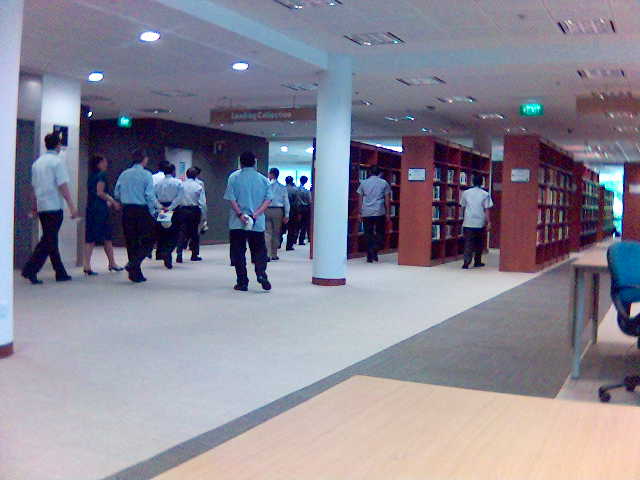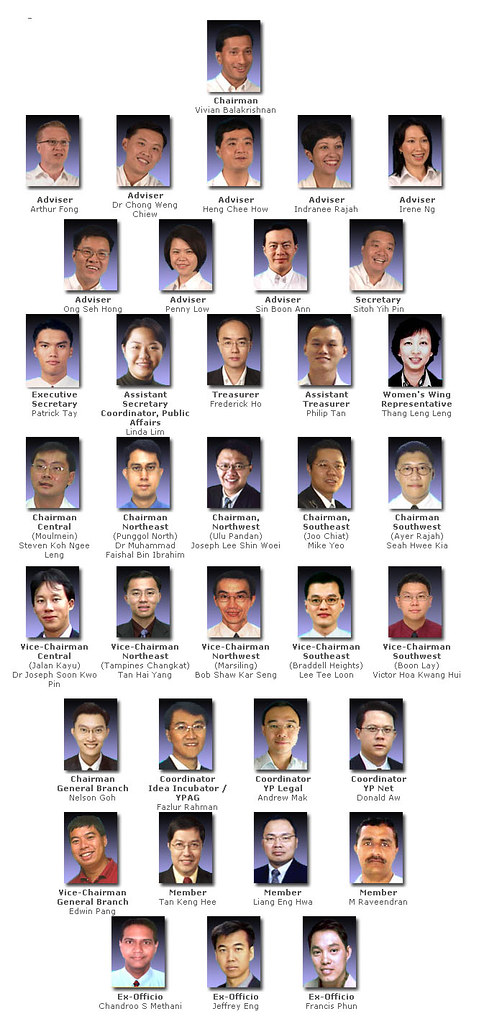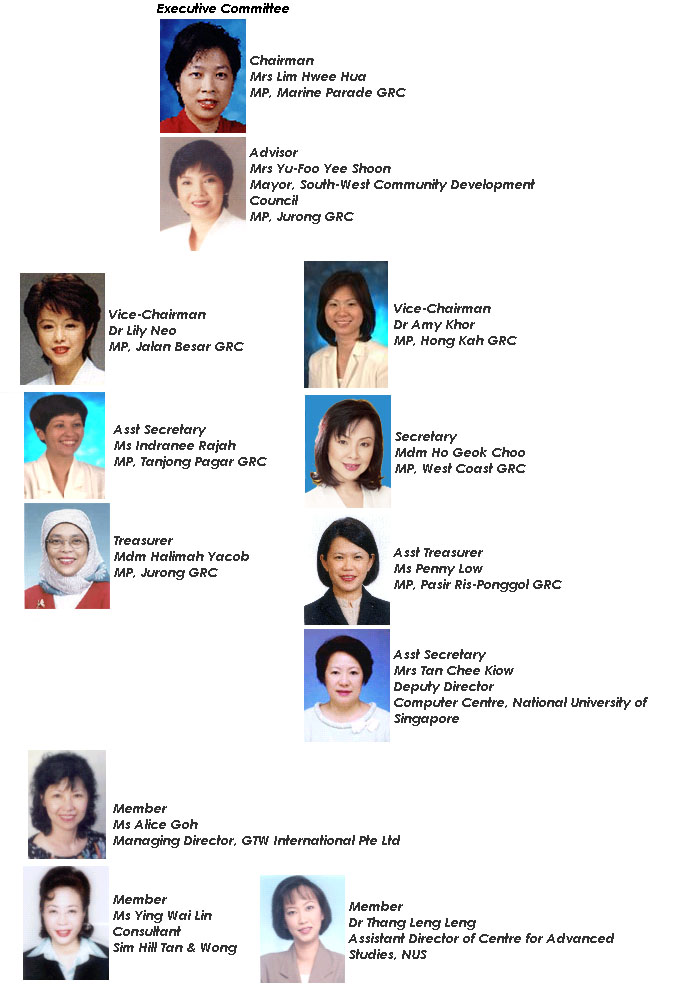Insights From Inside...
Perhaps, my so-called “reputation” precedes me that when I was typing this article, a couple of Ministers (Teo Chee Hean, Lee Boon Yang) and MPs (Abdullah Tarmugi, Low Thia Kiang, Lee Yoke Suan) came to visit me! Just joking, but coincidentally, they were “touring” at my university library when I was typing this article. Anyway, as promised, this is the article which I struggle to write and find public information to prevent myself from getting into any problems.
 The PAP was established in 1954 and their structure is a cross between our former colonial rulers, the British, and the Politburo of the Communist Parties (such as China’s CCP). Politburo, short for Political Bureau, is the executive organization for a number of political parties, most notably for Communist Parties. In theory, the party congress (for PAP it is the 1,300 party cadres) elects the Central Committee (for PAP, it is the Central Executive Committee), which in turns elects the Secretary-General (which will be the Leader of the Party and Prime Minister). For the PAP system, it is pretty much similar to that, except when electing of the Secretary-General it is slightly different and murky. It is similar to the British Parties System as it has a close tie with the labour unions such as NTUC.
The PAP was established in 1954 and their structure is a cross between our former colonial rulers, the British, and the Politburo of the Communist Parties (such as China’s CCP). Politburo, short for Political Bureau, is the executive organization for a number of political parties, most notably for Communist Parties. In theory, the party congress (for PAP it is the 1,300 party cadres) elects the Central Committee (for PAP, it is the Central Executive Committee), which in turns elects the Secretary-General (which will be the Leader of the Party and Prime Minister). For the PAP system, it is pretty much similar to that, except when electing of the Secretary-General it is slightly different and murky. It is similar to the British Parties System as it has a close tie with the labour unions such as NTUC.(Click on Picture to Expand)
 PAP Central Executive Committee (CEC)
PAP Central Executive Committee (CEC)For a start, like Singapore, PAP is relatively young and has only seen three party Secretary-Generals, of which, there is little challenge to the designated heir prior to the selection. Based on the past transitions, the then-Secretary-General (then-Prime Minister, eg: Goh Chok Tong) will usually suggest a nomination, (usually the 1st Asst. Secretary-General) to be the new Secretary-General, to the Cabinet and the CEC. After getting the mandate and endorsement of the CEC and Cabinet, he will then seek the approval from the Members of Parliament. The transition from Lee Kuan Yew to Goh Chok Tong was quite an interesting one as LKY preferred Dr Tony Tan but the CEC preferred Goh Chok Tong. In the end, the Secretary-General sided with CEC’s recommendation (and partly because GCT is also not going to pose any threat to LHL’s future leadership of the Party). However, since the leadership hand-over was only practiced twice in the history of the PAP, it is difficult to say whether this will be the standard procedure.
For the rest of the CEC members, they are voted in by the party senior cadres at the PAP Ordinary Conference. There are around 1,300 senior cadres in the PAP, which are senior leaders of the party (Ministers and MPs), former leaders (former MPs), past and present Branch Secretaries (which are the highest ranking non-MP official at constituency level, eg Kua Hong Pak who is the Managing Director of ComfortDelgro, and was the Branch Secretary of Teck Ghee constituency) and senior members of the PAP (ordinary folks that has long and outstanding service to the PAP). The highest vote will be the Party Chairman (currently, Lim Boon Heng, past chairmen includes Dr Tony Tan, Dr Toh Chin Chye) and the second highest vote will be the Vice-Chairman (currently, Dr Yaccob Ibrahim). Below is the line-up of the current CEC:
 Functionally, the CEC is the executive body and main decision-making power in the whole organization. Typically, most of the members are Cabinet Ministers or key government position holders. After the election of the CEC, the CEC will, in turn, appoint an HQ Executive Committee, which oversees most of its functional areas.
Functionally, the CEC is the executive body and main decision-making power in the whole organization. Typically, most of the members are Cabinet Ministers or key government position holders. After the election of the CEC, the CEC will, in turn, appoint an HQ Executive Committee, which oversees most of its functional areas.PAP HQ Executive Committee
The PAP HQ Executive Committee mainly works as an operation and management committee while the CEC sets the directions and decision-making process. The HQ committee has 12 core functions, each with their own Chairman and Committee but of which, two committees (Young PAP and Women’s Wing) are larger in size compared the rest of the 10. These two committees will be elaborated later.
 In addition, the HQ has an operating function which is to coordinate the functioning and activities within 5 districts (Central, North-West, North-East, South-West, and South-East). Each district will have a Chairman and a Vice-Chairman which are the Members of Parliament for the same district. Under them, they will have their own committees made up of 12 District Representatives. Biennially, all the Branch Secretaries will elect these 12 district representatives among themselves to sit in the PAP HQ Committee.
In addition, the HQ has an operating function which is to coordinate the functioning and activities within 5 districts (Central, North-West, North-East, South-West, and South-East). Each district will have a Chairman and a Vice-Chairman which are the Members of Parliament for the same district. Under them, they will have their own committees made up of 12 District Representatives. Biennially, all the Branch Secretaries will elect these 12 district representatives among themselves to sit in the PAP HQ Committee.  In the PAP HQ Executive, there are two separate committees (PAP Community Foundation (PCF) and PAP Policy Forum (PPF)) that functions quite independently. The PCF is headed by RAdm Teo Chee Hean and the PPF is headed by Ellen Lee, a women wing member and lawyer by practice. The PCF looks into community service projects for needy Singaporeans as well as the management of the PAP Kindergartens and works closely with the grassroots committees such as the CCC. For the PPF, it was recently setup to provide an avenue for ordinary party members and cadres to participate in policy dialogues and provide feedbacks to the Guest-Speaker Ministers via forums.
In the PAP HQ Executive, there are two separate committees (PAP Community Foundation (PCF) and PAP Policy Forum (PPF)) that functions quite independently. The PCF is headed by RAdm Teo Chee Hean and the PPF is headed by Ellen Lee, a women wing member and lawyer by practice. The PCF looks into community service projects for needy Singaporeans as well as the management of the PAP Kindergartens and works closely with the grassroots committees such as the CCC. For the PPF, it was recently setup to provide an avenue for ordinary party members and cadres to participate in policy dialogues and provide feedbacks to the Guest-Speaker Ministers via forums.If you can consider the CEC as the brains of the organization, the HQ is the body that controls the hands and legs.
Individual Constituencies PAP Branches
The appointments and elections of Branch Secretaries, Cadres, District Representatives and leaders can be quite complicating for ordinary Singaporeans. Maybe I can make it clearer. There are 84 constituencies in Singapore and thus, there are 84 Members of Parliament in each constituency. At each constituency, the MP is the Chairman of the Branch. The second highest appointment in the constituency (in PAP language is called Branch) is not the Vice-Chairman but is the Branch Secretary. The Branch Secretaries, are appointed by the MP, conduct the Meet-the-People Session each week and decides on matters pertaining to the local levels with the MP. The third in line would be the Vice-Chairman.
 The main task of the branches is to cater and service the needs of their voters and constituents in that district via the Meet-the-People Session (MPS). Note that I used the words “voters” and “constituents” instead of Singaporeans. This is because political parties, by theory, do not cater to all citizens but to their voters and constituents. Since the PAP has “conquered” most of the constituencies, they provide for all who support them and stay in their controlled areas.
The main task of the branches is to cater and service the needs of their voters and constituents in that district via the Meet-the-People Session (MPS). Note that I used the words “voters” and “constituents” instead of Singaporeans. This is because political parties, by theory, do not cater to all citizens but to their voters and constituents. Since the PAP has “conquered” most of the constituencies, they provide for all who support them and stay in their controlled areas.Each branch will also have a youth wing (in PAP Language is called Young PAP (YP)), of which, the branch YP Chairman are appointed by the individual MPs.
Young PAP (YP) aka Youth Wing
The YP is structured similarly to its parent, PAP. Starting from the bottom, each branch has its own youth members. From the youth members, the MP will appoint a Branch YP Chairman and Vice-Chairman. Similar to the District Committee, all Branch YP Chairmen will elect two representatives for their district, biennially. The highest vote will be the District YP Chairmen and the second would be the District YP Vice-Chairmen.
Once every few months, the District YP Chairman may call for meetings with all the Branch YP Chairmen to gather the information, feedback and views to reflect them to the YP Executive Committee, which is headed by the YP Chairman (appointed by the CEC). The YP Chairman, Dr Vivian Balakrishnan, will then channel any relevant information to the PAP HQ Executive Committee or the CEC, if necessary. Historically, past-YP Chairmen have always been prolific Ministers. The very first YP Chairman was current-PM Lee Hsien Loong. Later, he passed the baton to now-Foreign Affairs Minister George Yeo. Minister Lim Swee Say took over from him few years later and most recently, Dr Vivian Balakrishnan was added into the list of prolific Ministers as YP Chairman.
 Women’s Wing (WW)
Women’s Wing (WW)The women’s wing is smaller compared to the size and membership of the YP. In recent years, under the leadership of Lim Hwee Hua, the WW seems to be quite active. Most notable and recent event led by the WW was the community project, the Headstart Fund for needy Singaporeans.
 Conclusion
ConclusionHopefully, I’ve demystified some of the structure and insights into the PAP in this article. On the contrary, I might have made some people even more complicated than ever (hope not!). A lot of people often criticize the PAP for being too elitist and closed-door to ordinary folks. I think this is one misconception that this article could help to clarify. At various levels of decision-making and action, there are avenues where ordinary card-carrying Singaporean member (of PAP) can participate. Ordinary Singaporeans who join the PAP have quite a lot of access to Ministers and MPs to voice their opinions. The important thing is that the people who join and have the chance to speak to the leaders, must “speak truth to power”. I think in the PAP (some of the branches and grassroots) have too many “Yes-men” where chairmen and branch secretaries surrounding the MP misled them to think that all is well at the ground when it is not. Maybe it is my principles, but I’m one who will said “NO” if I have to, but not “NO” just for the sake of the argument. Anyway, this article is not supposed to be on me.
Nonetheless, the PAP is a 50 year old organization that has quite a resilient structure and multiple functional units where ordinary citizens can voice their concerns. It is not easy to understand or see it at first look but its diverse functions and committee shows its age and stability of the party.
Just to cover my #$^, all information are publicly available (via National Library, newspapers and internet).

